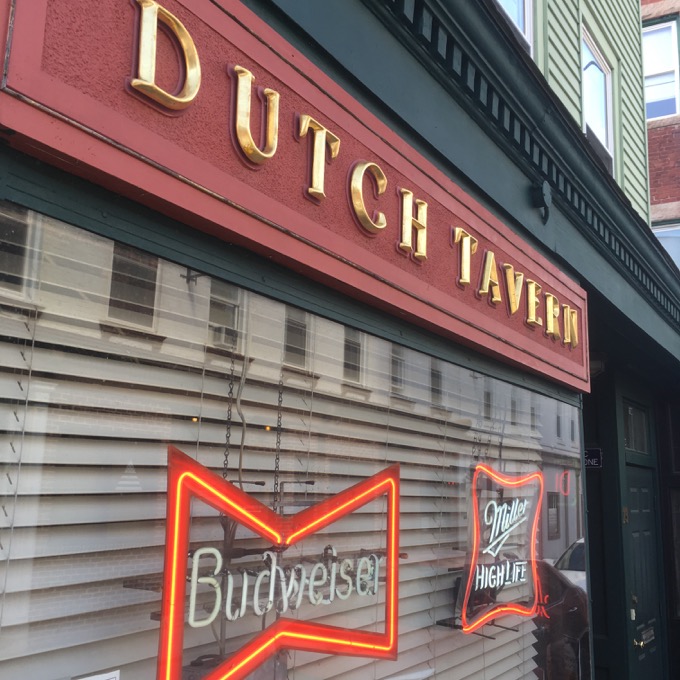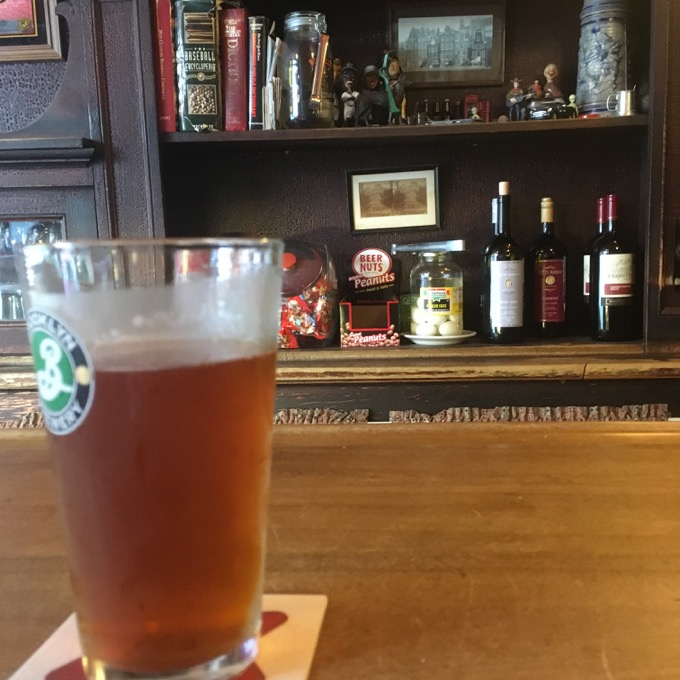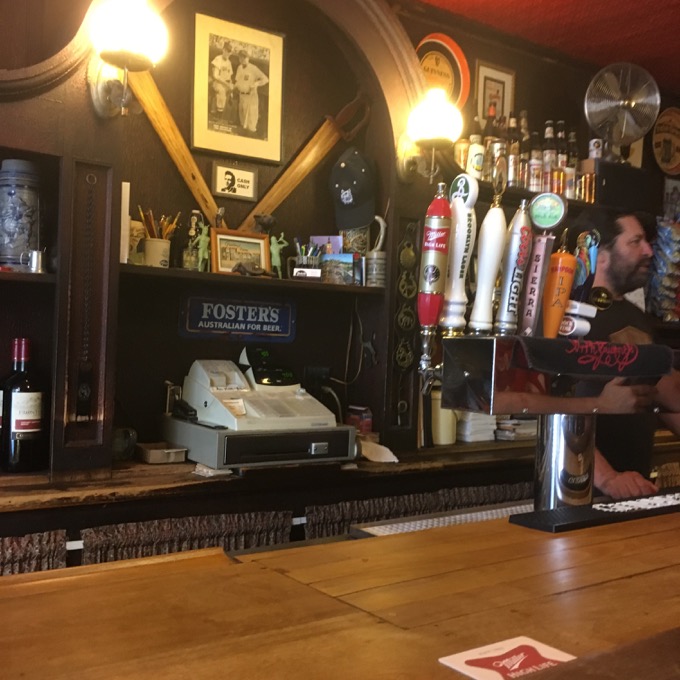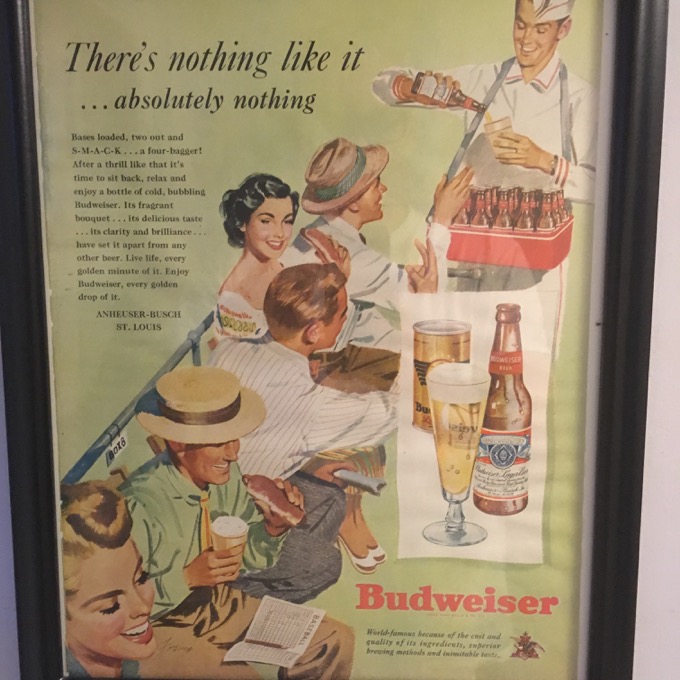I’m in Dutch Now
Dutch Tavern, New London
May 2018
Finally.
I’ve finally begun my journey to take a seat and have a beer at all of Connecticut’s few remaining true, classic taverns. What’s that? There are a billion bars all over the state? What differentiates these 8 or 9 particular places?
Glad you asked… History! Quirkiness! Archaic state liquor laws!

This is gonna be fun. Connecticut offers/requires licensing for everything. Tucked away, there exists a “tavern liquor” license, which I believe was created after prohibition. A tavern permit allows its holder to sell beer, wine, and cider up to 6% alcohol for consumption on the premises with or without the sale of food.
This is an incredibly limiting license; no liquor. No double IPAs or imperial stouts. (Here’s what’s available at The Dutch.) And, the thinking goes, this means no drunkenness. In the true tavern spirit, a couple pints of lower ABV beer results in conversation and conviviality. Many of these places have only one TV at most. Regulars populate the same stools daily. They are all tiny. Most are old. Some have existed as they are today for many decades.
New London’s Dutch Tavern is all of that. (They also have a limited menu that I had no interest in, but rumor has it that their burgers are quite good.)
Located on Green Street, a glorified alley in downtown New London, The Dutch has been a beacon for drinkers and socializers for nearly a century. In its own way, it is as much a museum as many museums across the state. The exhibits would be the regulars whose well-worn wooden stools are molded to their butts. During my visit on a late weekday afternoon, I am certain I sat on a regular’s stool who quietly took up residence two spots down and patiently and quietly waited for me to vacate his spot.

The Dutch Tavern is very, very small and dark. But is also warm and inviting at the same time. It has never pretended to be anything beyond what it is. New London is a city rich in history, lore, and let’s be honest, issues. What better place to talk about all of those things than a beloved little tavern close enough to the Sound to taste the salt in air before dipping in for a drink?
The New London Day has written about the Dutch several times over the last few decades, as they seem to understand what such a place means to the city. Below I’ve excerpted a very long and very wonderful piece by Dan Pearson in 1999. Though it was written almost 20 years earlier than I’m writing this page, nothing has changed other than the old guys mentioned are certainly all now deceased. Peter Detmold, guitarist and singer for the rock band the Reducers, and his partner, Martha Conn still own the joint.
In fact, when I visited I sat and had a beer next to Peter as he quietly read the paper by the fading afternoon sunlight. It was quiet. A couple old guys drank in silence; clearly longtime friends whose friendship transcends conversation. I tried to absorb as much of the Dutch as I could. Tried to sort out how a tavern serving only low(er) ABV beer and wine continues to exist in 2018. Then I realized… if I had a neighborhood tavern near me, that’s where I’d go. I like reading newspapers at bars. I don’t like small talk. I like low(er) ABV beer.
If all of that makes me old, I’m okay with that. Just as The Dutch Tavern is okay with its timeworn and barebones self. Cheers to that.

The Dutch Taps Into History
By Dan Pearson
(Excerpted; full article – and more – here)
In 1912, when Eugene O’Neill was a cub reporter with a thirst for ale, a 10-ounce Narragansett or Ballantine could be had for a nickel in any one of the 27 taverns that lined Bank Street.
After a day covering society weddings or sleeping off a hangover in the newsroom of the New London Morning Telegraph, O’Neill would find himself within walking distance of 69 bars where he could drink away the pain of his family life on Pequot Avenue.
It’s a good bet he squinted against the gaslights of every one of them.
Until Prohibition and the world wars changed the way America socialized, the tavern was every neighborhood’s community center, its belly stove providing the heat that ramshackle apartment buildings and Federal-era homes could not.
“It’s never really changed. It has always been just like home, or at least the way you wanted your home to be,” Al “Scottie” Devlin, 80, a longtime Dutch regular, said, sitting at one of the tavern’s tables. “It was always congenial like any neighborhood tavern where you meet your friends, tell your tall stories and drink all the beer you could for whatever money you had.”
Since it got a tavern license from the State Liquor Control Board when Prohibition ended in 1933, the Dutch has been owned and operated by five men and one woman. Attempts to make changes – albeit few and minor – have caused ripples. Sprinkling paprika on the potato salad had some patrons taking sides.
During Prohibition, the bar was used as storage space for tires and scrap rubber by the property’s owners, the W.S. Alling Rubber Co. In 1933, Mauritz M. “Dutch” Nauta, the former steward at the Order of Hermann Sons, more commonly known as the German Club, bought the building from the rubber company, built the 25-foot-long bar, and advertised that he had “spared no expense in outfitting the establishment to meet the demands of a high class trade.”
Edward Rothen and Louis “Wicky” Grabner Jr., bartenders at the German Club, bought the business in 1951 for $1,100. Except for inserting their recipe for German potato salad into the afternoon menu and employing their friend, George Connaughton, to help with the lunch rush, they made almost no changes.
In 1978, Peter Burgess, a few years out of the Navy, left his father’s contracting business in Groton to take over the tavern. Much to the consternation of the silver-haired regulars who sat laconically at the bar, Burgess installed a Pac-Man video game and let a group of young performers stage original dramatic pieces in the bar.
Last summer, after working behind the bar off and on for 15 years, Peter Detmold and Martha Conn, both a part of the vibrant arts scene in the city during the late 1970s and early 1980s, became the latest New London residents to extinguish the Dutch’s neon lamp each night.
Before the Dutch, another tavern operated in the same space on Green Street. In 1906, when bars on the corners of Green and State and Green and Golden streets closed or moved, John H. Murphy, a steward at the Thames Club, opened The Oak. Legend has it that O’Neill, the future Nobel Prize-winning playwright, drank there, probably in 1912 and 1913 during his days as a hard-drinking reporter when he lived in his parents’ summer home on Pequot Avenue.After Prohibition, and for the next decade, according to Nauta’s son Bob, however, O’Neill, who was third cousin of Nauta’s wife, Julia Doyle Kelly Nauta, unequivocally came into the Dutch on sporadic Friday nights to play Pitch with Nauta, Art McGinley, a sports editor at The Hartford Times and old friend of the playwright’s, and the Dutch regulars who remembered the playwright from his hellion days as a reporter.
In fact, it’s possible that O’Neill combined his recollections of The Oak and the Dutch with those of the bowery dives he frequented to create Harry Hope’s bar in “The Iceman Cometh.”
According to biographers and legend, O’Neill drank so heavily at The Oak and elsewhere that he often returned to the Telegraph newsroom, curled up on his desk and slept. If The Oak’s interior was anything like that of the Dutch’s it might have been a suitable place for O’Neill to escape the eyes of society mothers worried that the aspiring writer was turning their daughters to demon drink.

Today, a patina covers every bit of reflective brass and glass in the tavern, combining with the mahogany and chestnut-colored wainscoting to inspire introspection. The beeps and buzzes of a pinball machine interrupt the low monotone of a baseball announcer’s play-by-play. A clock bearing a Guinness logo sounds the hours, but, for the most part, the Dutch exists quietly outside of time.
…
The tavern’s finished and refinished tables have slots for drinks and cards. Sepia-tinted photographs of downtown New London and Dutch patrons mix with such mementos as swordfish bills, rusted tin beer trays, dusty cans of Banks and Billy Beer, an antlered jackalope head, and a charcoal drawing of O’Neill. Five feet from an autographed photo of Hall of Fame slugger Orlando Cepeda and a shelf of sports trivia books hangs the bar’s most enduring icon, a 1943 picture of Red Sox outfielder Ted Williams shaking hands with Babe Ruth – the pair’s first meeting – in Boston’s Fenway Park.
Devlin, the venerable regular, said that since World War II the Dutch has been a great place to play pitch and talk baseball because the beer and the food are cheap. The bar keeps Devlin’s favorite Ballantine on hand for his weekly visits.
Before Devlin ever set foot in the bar, however, there were already a group of men from the German Club, sailors, longshoremen, and downtown merchants who came for the Dutch’s potato salad and pot roast, made by Nauta’s wife Julia, and the nickel Narragansetts and Hull’s. A native of Lleuwarden, Holland, who came to America, by hopping a ship, Nauta, the Dutch’s namesake, worked his way north from Baltimore to New London in the belief that there was a large Dutch population in the city. He was wrong, so he joined the Coast Guard, returned and began working at the New London Shipping and Engine (later Electric Boat) and began picking up extra money bartending at the German Club.
In 1933, when prohibition ended, the quiet and stern bartender, who eventually lost a leg to diabetes, bought the Dutch. For the next two decades, he would walk down or take the trolley from Ledyard Street at 6 p.m., to play cards with the entirely male clientele who frequented the tavern. At the time, the bar was exactly the same as it is now except for the seafaring and nautical prints that hung on the walls as reminders of Nauta’s Coasty days and a ornate glassware Planter’s Peanut jar. With the sleeves of his white shirt rolled, smoking a cigar, Dutch would say that the tavern enabled him to “raise seven kids on nickel beer.”
…

Detmold said that when he first walked into the bar at 17 or 18, the old men there looked at him as if he were a mosquito they hoped would go away. But because of the cheap Schmitts and Pabst and the placid interior, Detmold decided to stay.
“I have a real affection for those old guys,” Detmold said. “I always felt it was their place.”
Detmold said that while the city has changed the bar hasn’t. The New London Mall and later Crystal Mall wiped out small downtown businesses. Afternoon drinks and alcohol in general are less commonplace. The simple tavern that serves only beer and wine is all but an anachronism.
Nevertheless, a new generation has taken up baseball scorebooks at the bar. During weekday afternoons, tables are still filled by stockbrokers, city employees, deliverymen and retired pipefitters who sip a lager or cola while they read the newspapers.In the summer, State Street attorneys in seersucker suits still sit by the fan with a beaded glass of Shaefer and wax nostalgic about the days after World War II when neighborhood taverns like the Dutch graced nearly every street corner.
Ray Ware no longer comes in off the Fishers Island ferry after a day of house painting to eat shards of glass. Cowboy Sheehan no longer shadowboxes in the tavern’s picture window. Harry Rodvogin, who lived for free in the Lighthouse Inn for a quarter century in return for his paintings, no longer comes in carrying his calfskin of wine, loaf of bread and wedge of cheese. Nauta’s nationally known bowlegged cat, who was featured in a Ripley’s Believe it or Not panel, no longer sleeps in the alcove window.
But, the Dutch is still open, the Red Sox still haven’t won the World Series since the tavern opened under that name, and the beer, six days a week, seven during football season, still is cold.
“When the Reducers toured we used to look for places like the Dutch and I realized that except for maybe in New York or Boston there aren’t places like this,” Detmold said. “I started worrying that the place would change and there would be too many neon signs and a CD jukebox.
“I feel like I’m carrying on a tradition. The Dutch will do fine regardless of what happens to New London. If New London falls down, it will last. It’s lasted this long.”
![]()
Dutch Tavern
CTMQ’s CTMQ’s True Taverns

Leave a Reply